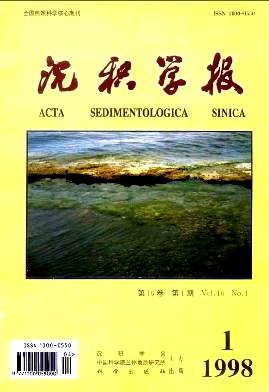Jing Huijuan, Li Yuci. Nereites Trace facies(Devonian) in the Northern Bel t of West Qingl ing Mountains and Its Environment Anal ysis[J]. Acta Sedimentologica Sinica, 1998, 16(1): 15-21.
| Citation:
|
Jing Huijuan, Li Yuci. Nereites Trace facies(Devonian) in the Northern Bel t of West Qingl ing Mountains and Its Environment Anal ysis[J]. Acta Sedimentologica Sinica, 1998, 16(1): 15-21.
|
Nereites Trace facies(Devonian) in the Northern Bel t of West Qingl ing Mountains and Its Environment Anal ysis
- Received Date: 1997-03-06
- Rev Recd Date:
1997-08-20
- Publish Date:
1998-03-10
-
Abstract
Widely exposed in the northern belt of West Qingling Mountains,the Shujiaba Formation (Devonian) isa set of extremely thick terrigenous clastic rock measures. Two sharply different viewpoints on the paleogeog-raphy environment of the formation still exist,i. e. shallow sea and deep sea facies. This paper placed emphasison the 43 ichnogenera discovered by the authors to discuss the paleoenvironment information provided bythem. The description and plates of the 43 trace fossils of the Shujiaba Fm. have been reported openly,and theyare: Acanthorhaphe,Arthrophus,Belorha phe,Bostricoph yton,Buthotrephis,Chondrites,Cochilichnus,Cos-morhaphe, Dictyodora,Fucusopsis, Glockeria,Gordia,Granularia,Helicolithus,Helminthoida,Helminthopsis,Lennea,Lophoctenium,Megagra pton,Neonereites,Nereites,Paleohelminthoida,Paleod ict yon,Planolites,Pro-topaleodicyon,Protovirgularia,Rhabdoglyphus,Rhabdoichnus,Rusoph ycus(?),Saerichnites,Sagittichnus,Scolicia,Skolithos,S pirophycus,S pirorha phe,Sguamodictyon,Subphyllochorda,Sublorenzinia,Subularia,Ta phrhelminthoida , Ta phrhelmintho psis , T uberculichnus , Urohelminthaida. Some cognition was reached according to the study on the trace fossil groups mentioned above,that is,1)Classified in terms of trace facies,only a few ichnogenera existing in the near source turbidite of trace groupin the Shujiaba Fm. belonged to the Skolithos trace facies,but a majority of trace fossil ichnogenera belongedto the Nereites facies. They were preserved on the interface between Section Tc and Te in the thin-beddedturbidite formed in the distal area of turbidity current. According to the researches at home and abroad,itcould be seen that it is the unique feature of th trace fossil assemblage in vertical distribution in turbidite mea-sures or flysch facies that the trace facies of deep and shallow water co-exist in a single depositional profile,just like the Shujiaba Fm. 2)Classified according to the morphology,the already discovered trace fossils were predominated by thecurved , spiral, regular snakelike and netlike species. Nowadays,these complex and regular geometrical patternshave already become the important sign to distinguish the deep water trace fossils. 3 ) According to the ethological classif ication,the 43 ichnogeriera bassically,belonged to the feeding trailand trail. And the latter was generally in the leading role. This kind of trace fossils was mainly distributed atthe bottom of tranquil water body in abyssal-byssal areas. 4 ) Classified according to the distribution characteristics of water depth,the trace fossil of the ShujiabaFm. was predominated by the deep water members,of which the water depth distribution ranges from thedistal one to the byssal trough one. From the discussion above,it could be seen that the trace group in the Shujiaba Fm. was formed in abathyalbyssal environment related to turbidity current , and the largest water depth in deposition period couldsometimes exceed 2000m.
-
References
|
[1]
|
1 晋慧娟,李育慈.西秦岭北带泥盆系舒家坝组深海陆源碎屑沉积序列的研究.沉积学报,1996,14(1):1一10
2 高振中等.深水牵引流沉积一内潮汐、内波和等深流沉积研究.北京:科学出版社,1996. 1-42
3 李育慈,晋慧娟.西秦岭北带泥盆系中的遗迹化石及其环境意义.中国科学B辑,1993,23(12):1322-V1328
4 晋慧娟,李育慈.西秦岭北带泥盆系遗迹群落在浊积岩系中的分布特征.沉积学报,1997,15(1):1一6
5 Ksiazkiewicz M. Observations on the Ichnofauna of the Polish Carpathians, In: Crimes T P,Harper J C,eds. Trace Fossils, I. 1970. 283322
6 Crimes T P, Trace fossils of an Eocene deep-sea Sand fan. North- ern Spain. In: Crimes T P, Harper J C, eds. Trace Fossils. I. 1977. 71
7 Ekdal A A, Bromley R G, Pemberton S G. Ichnology, The use of trace fossils in sedimentology and stratigraphy, SEPM. 1984. 1- 316
8 Ksiazkiewicz M. Trace fossils in the flysch of the Polish Carpathi- ans. Palaeontologica Polonica, 1977,36:1一208
9 霍福臣,李永军.西秦岭造山带的建造与地质演化.西安:西北大 学出版社,1995.10-30
10 杜远生.西秦岭造山带泥盆纪沉积地质学和动力沉积学.岩相古 地理,1995,15(4):47-62
11 Seilacher A. Uber die Methoden der Pafichonlogie, studien.von Palichnologie: Neues Jahrb. Geol. Palaontol.,Abh,1953,96:421-452
12 Chamberlain C K. Bathymetry and Paleoecology of OuachitaGeosyncline of Southeastern Oklahoma as determined from tracefossils. Amer,Assoe. Petrol. Geols. Bull. 1971,55:3450
13 Kern J P. Trails from the Vienna woods. Paleoenvironment andtrace fossils of Cretaceous of Eocene flysch. Vienna, Austria.Palaeogeogr. Palaeoclimatol. Palaeoecol. 1978,23:230-262
14 Bottjer D J. Trace fossils from an upper Cretaceous deep-sea fan,Simi Hills, California. In; Link M H, Squires R I,Colburn I P,eds. Simi Hills Cretaceous turbidites, southern California. Pacificsec. Soc..Econ. Paleontols. Minerals. Gdbk. 1981b,59-62
15 杨式溥,宋志敏,梁定益.西藏阿里地区晚石炭世一早二叠世复理石相遗迹化石.地球科学,1983a,1:93-104
16 杨式溥.青海果洛、玉树地区二叠纪和三叠纪复理石相遗迹化石.沉积学报,1988a,6(1):1-12
17 晋慧娟,李育慈.准噶尔盆地晚古生代深水斜坡沉积中的遗迹相及其环境分析.中国科学(B辑),1991,4:408-V 415
18 李育慈,晋慧娟.西秦岭北带泥盆系中的遗迹化石及其环境意义.中国科学(B辑),1993,23(12):1322-1328
19 晋慧娟,李育慈.西秦岭二叠纪一三叠纪遗迹化石及其环境意义.地质科学,1995,30(1):321一328 |
-
-
Proportional views

-






 DownLoad:
DownLoad: